
FAR FOREBEARS
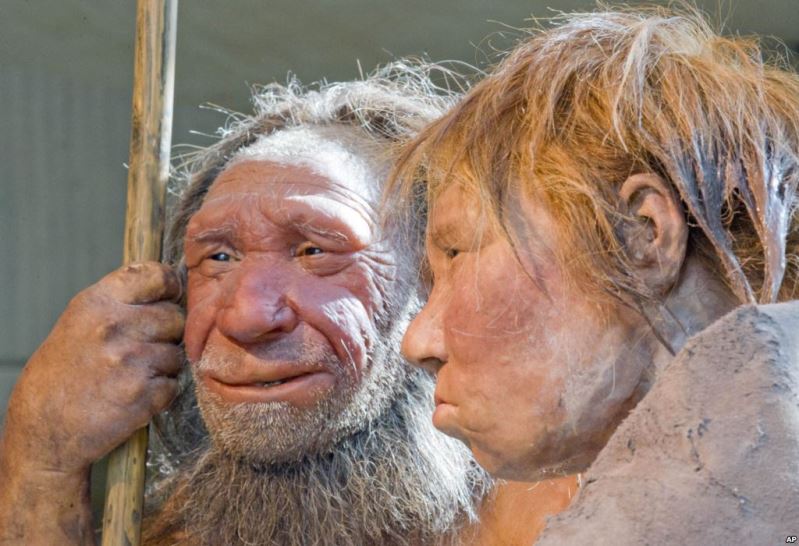

|
FAR FOREBEARS |

|
|
* Early human evolutionThe driving forces behind human development in body and mind are discussed. Many human fossils are found in the open savannahs of the African Rift Valley, which seem to indicate that this is where our bipeds were born.. DNA and also molecular phylogenetic research shows that the ape and man last shared a common ancestor around 7 to 5 million years ago and they mainly lived in forests and wooded areas. (1) Then the two separated. (2) |
Paleolithic or Old Stone Age |
|
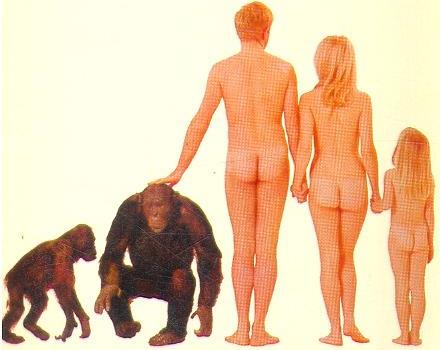
Naked ape, Desmond Morris. |
The food of the forerunners of man consisted not only of fruits and roots, but also of meat, just as with the apes they hunted small animals or the young of their own kind. Unlike the monkeys, eating carrion became an increasingly important source of food. This may have been the main driving force behind evolution. The legs grew stronger and longer to run faster to reach the prey of large predators earlier than hyenas and vultures. The arms became less powerful and smaller because they were used less and less for climbing. The people became two-legged (3) |
Coat lossIn itself, a coat works well against heat, but if the organism becomes more active and therefore produces a lot of heat itself, things go wrong, especially if the organism grows larger. The larger the size of an animal, the smaller the skin surface becomes relative to the body size. There are plenty of active little monkeys, but the larger chimpanzees and other great apes only have relatively short intense activities, and then rarely in full sun. Larger Homo erectus's many joggers in full sun tripled its heat problem. Its larger size made the heat problem worse. The insulating effect of the fur will then have a negative effect. That is why the extremely large elephants and rhinoceroses are also bald: too big and too active. In that whole complex of changes of running, expansion of the sweat glands and general human incarnation, man has shed his fur. Overheating drove us to baldness. Thinking about human evolution once placed great emphasis on the size of our brains, and not without reason, but about twenty years ago it was discovered that our bodies not only think well, but above all are exceptionally suitable for running. It is a complete cohesive system of springy Achilles tendons, muscles that balance our head when running, many slow thigh muscles and an exceptional amount of sweat glands (five times as many as the chimpanzee). Chasing prey turned out to be an effective way of hunting. Pursuit hunting is all about giving the prey no rest. Ultimately, trained humans have better endurance than almost all animals. After hours of pursuit, the prey remains dead tired and dazed waiting for the hunter, who can finish the job with a spear. It is not unlikely that hunting became a driving force behind the hair loss of H. erectus. (4) Homo ErgasterThe Homo ergaster is known from the Early Pleistocene between 1,9 and 1,4 million years ago from Koobi Fora (Kenya, East Africa) and Swartkrans (South Africa) among others. Homo ergaster probably had a body height of 1,80 m. The body weight was between 50 and 68 kg, while the brain volume was between 600 and 910 cubic cm. Homo ergaster was the first hominid with the same physique as that of modern humans Homo ErectusThe Homo Erectus is considered to be the first human species to leave Africa. There are indications that Homo erectus was already present in China and Java 1,8 million years ago. He was discovered on Java by the Dutch paleontologist Eugène Dubois, and is also called the Javanese. He measured 1,80 meters and had a brain volume of 850 to 1100 cc. |
|
Fossil remains of Homo erectus are found throughout Eurasia and North Africa. In Europe Homo erectus lived for more than one and a half million years. Their tool remains are found spread over Europe and Asia, as in Pirro, Southern Italy, in the Caucasus and South China. Human remains are only found in Africa. (9) The Homonines Heidelbergenses already had a very modern appearance. They are called after his first location in Germany. They lived in Africa, Europe and West Asia from 700,000 to 200,000 years ago. They are possibly direct ancestors of the European Neanderthals and the Asian Denisovans. |
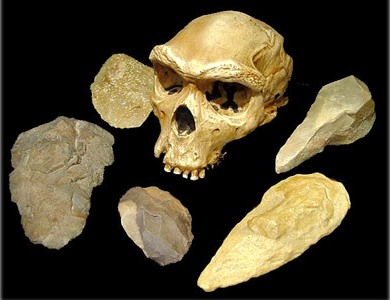
Homo heidelbergensis with tools (hand axes) (10) |
|
* The Denisovans The Denisovan Y chromosomes split around 700 thousand years ago from a lineage shared by Neanderthal and modern human Y chromosomes, which later, around 370.000 years ago diverged from each other.
In the Denisova cave in the Altai Mountains of southern Siberia, a finger bone was unearthed which was dated to between 28,000 and 44,000 BCE. The bones of these people were about twice as heavy as that of modern man. The mitochondrial genome could be determined well. They are a sister group of the Neanderthals. They went apart about three quarters of a million years ago. Denisovans have quite a few genes of an older unknown humanoid. DNA fragments passed down from these ancient hominins to modern people living in Island Southeast Asia and New Guinea now suggests that the ancestry of Papuans includes two distinct Denisovan lineages, which had been separated from each other for hundreds of thousands of years. (12) * The Neanderthals
Reconstruction of a Neanderthal man and a Homo Sapiens woman in a museum in Mettmann, Germany. .A long time later the Neanderthals from Africa entered Eurasia. The split between Homo Sapiens and Neanderthals is estimated to have occurred in Africa. The estimated modern human-Neandertal TMRCA is 387 ka (95% HPD 344 to 432 ka). (13) The phylogenetic relationships of archaic and modern human Y chromosomes differ from population relationships inferred from their autosomal genomes, and mirror the relationships observed on the level of mitochondrial DNA. This provides strong evidence that gene flow from an early lineage related to modern humans resulted in the replacement of both the mitochondrial and Y chromosomal gene pools in late Neanderthals. This replacement is plausible if the low effective population size of Neanderthals resulted in an increased genetic load in their Y chromosomes and mitochondrial DNA relative to modern humans. (14) The oldest fossils of Neanderthals are found in the Sima de los Huesos cave in the Sierra de Atapuerca in Spain. They are estimated at 300,000 to 500,000 BCE. (15) The world's very first Neanderthal remains were discovered in Belgium in Engis, a suburb of Liège, in 1829. In Belgium other sites were later found at Sclayn, Spy-sur-l'Orneau, Trooz, La Naulette and Veldwezelt. Neanderthals ware named after the Neanderthal (Neander Valley) the archeologial site in Germany where in the year 1856 archaeological skeletal remains are found and have been described for the first time in the well-known German thorough manner. 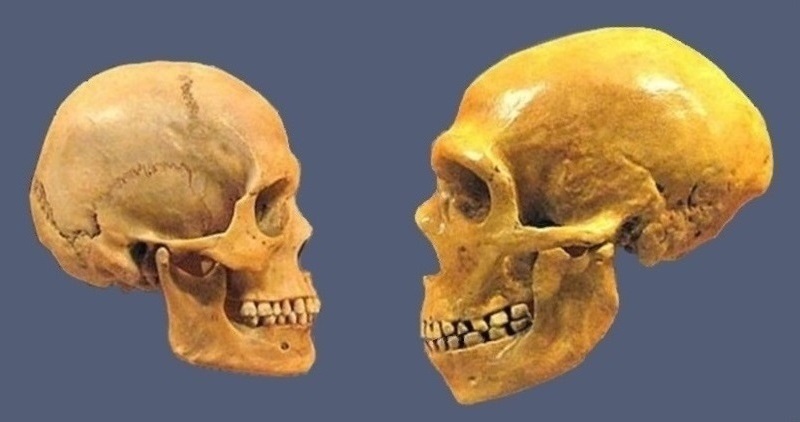
Two Skulls, one of a modern man and one of a Neanderthal in Museum of Natural History in Cleveland.
Archeolic remains left by Neanderthals include bones and stone tools, which are found in Eurasia, from Western Europe to Central and Northern Asia. Skeletons and stone tools have been found in Israel, which date from 120,000 to 150,000 BCE and in southern China from about 130,000 BCE, as well as a suspected necklace of eagle talons that would have belonged to Neanderthals living in the same time in present-day Croatia. 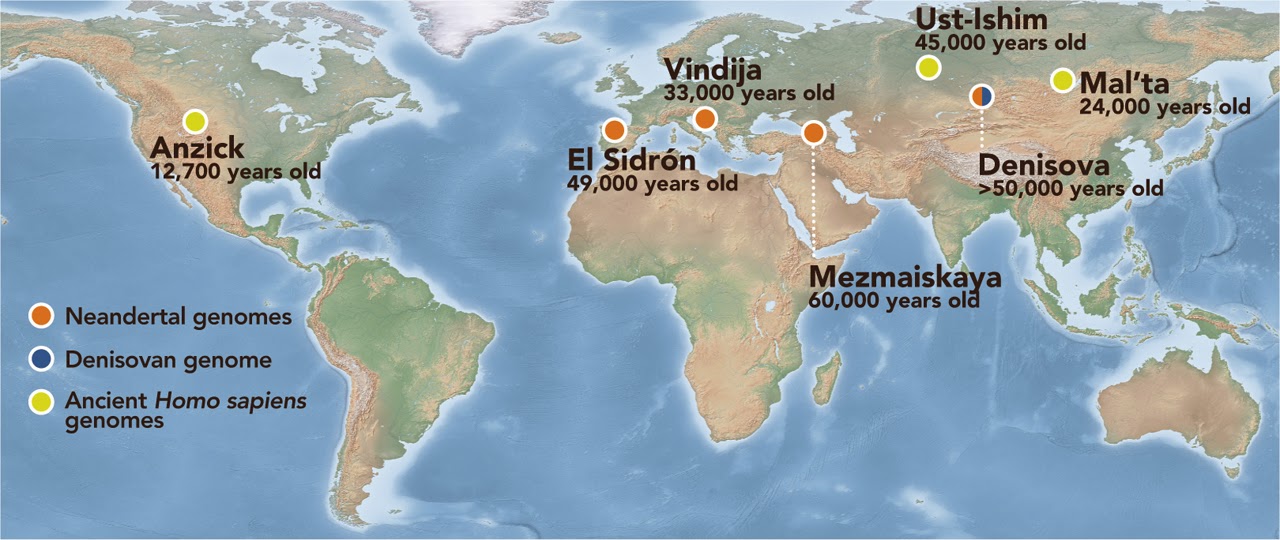
At these sites remains are found from who archaeologists could determine the genome. The mtDNA sequences of Neanderthals are completely outside the present human variations; the same applies for the Y-DNA if the age of the first common ancestor is proposed as being younger as a result of reduced diversity, caused by major population declines during which lines became extinct, which could have been a common occurrence. The Neanderthals had only 4 copies of AMY1 in their saliva, while we have in our genes many copies of the α-amylase gene AMY1. In each population ranging from 4, at some Finns, to 18. Europeans usually have 15. Very likely they got abdominal cramps and diarrhea after eating of roots and tubers. Their food consisted of meat from large mammals, fish and fruit with loose sugar. They were not skilled enough to hunt small animals. Ear bone of a young Neanderthal girl
Collections at the Muséum National d'Histoire Naturelle à Paris. A very complete temporal bone with an auditory ossicle: a complete stapes. Virtual 3D reconstruction techniques enabled this ossicle to be extracted virtually. Skeleton of a 2-year-old Neanderthal child found between 1970 and 1973 and named La Ferrassie 8. The Extinction of the NeanderthalsWhen the Neanderthals became extinct is not entirely clear. Spain is probably one of the last refuges. Around 39,000 years ago a supervolcano near present-day Napels dropped an estimated three hundred cubic kilometers of ash across Europe, separating archaeological layers preceding it from those that succeeded it. Almost no Neanderthal remains or tools are found above it. (18) * Gene FlowAlthough the split between modern humans (Homo sapiens) and Neanderthals, based on mt-DNA differences, occurred 400,000 years ago, still in Africa, there have been after the exodus of man out of from Africa, probably in the Near East fertile mutual sexual contacts twice. The first time with the first group modern humans between about 84,000 and 70,000 BCE, the second time between about 45,000 and 40,000 years ago with the second great group. (19) This gene exchange from Neanderthals contributed up to 2% of the genetic material of European people. (20) Interbreeding with Neanderthals helped modern humans to adapt to new environments just as interbreeding with Denisovans did. Versions of keratin biology genes derived from the Neanderthals were preserved in the modern humans by the process of natural selection, probably because keratin is an essential component for hairy skin as protection against the cold climate of northern Eurasia. The Neanderthals had already been adapted to this. (21) There was also gene flow from a population related to the Denisovans into the ancestors of present-day aboriginal people from New Guinea, Australia, and the Philippines. It is notable that the populations today that contain the largest proportion of Denisovan ancestry are in Oceania. (22) A detailed analysis of the DNA of 355 modern humans, mainly from Papua and Oceania, shows that their ancestors mixed twice with two different groups of Denisovans, once around 45,000 years ago and a second time around 25,000-21,000 years ago (with a margin of several thousand years). This makes the survival of the Denisovians very likely up to 20,000 years ago. (23) * Homo sapiensThe populating history of the WorldThe modern human TMRCA is estimated at 268.000 ybp (95% HPD 238 to 301 ka) ( 23a) The oldest Homo sapiens fossils were hitherto assigned to Omo Kibish in Ethiopia, about 195,000 years old, and Herto, also in Ethiopia, about 160,000 years. The findings of Israel from the Skhul / Qafzeh hominids date to about 150,000 years ago. In June 2017, newly discovered human fossils from Jebel Irhoud in Morocco, were reported, dated to 315 ±34 thousand years ago. That is older than expected. Particularly interesting is that the fossils found in Ethopia exhibit certain anatomical characteristics that are different from those found in Jebel Irhoud. These findings suggest that the Irhoud man is from a crossing between Homo sapiens and an unknown archaic African species. (24) Homoids appear to have entered Eurasia more often during these early periods. Two fossilized human crania (Apidima 1 and Apidima 2) have been found in the Apidima cave in southern Greece. Apidima 2 dates from more than 170 thousand years ago and has a Neanderthal-like morphology, but Apidima 1 displays a mixture of modern human and primitive characteristics dates from more than 210,000 years ago. (25) Between 50,000 and 70,000 BCE some humans left Africa and went to the Arabian peninsula. From there groups went to Iran, India, Indonesia and China. Some of them reached Indonesia and went further to New Guinea and Australia. They largely retained their black skin. (26) The group from which the present world population originated, arrived from Africa in Eurasia about 59,000 and 44,000 years ago. They had fruitful contacts with Neanderthals and Denisovans. Fertile offspring have come from this, but only when the woman was a Neanderthal or Denisovan, not the man. In a relatively short period of time, They have lost out to us in a relatively short time. They have lost out to us in a relatively short time. (27) The wave of modern humans, making up the present-day world population, entered from Africa into the Near East around 50,000 years ago. They had fruitful contacts with the Neanderthals living there. From them came multiple highly divergent Basal Eurasian Lineages. One lineage went to Northern Eurasia in a relatively agreeable time during the Ice Ages (interglacial). Another went east into Asia, and some lineages stayed in the Near East for millennia. (28) 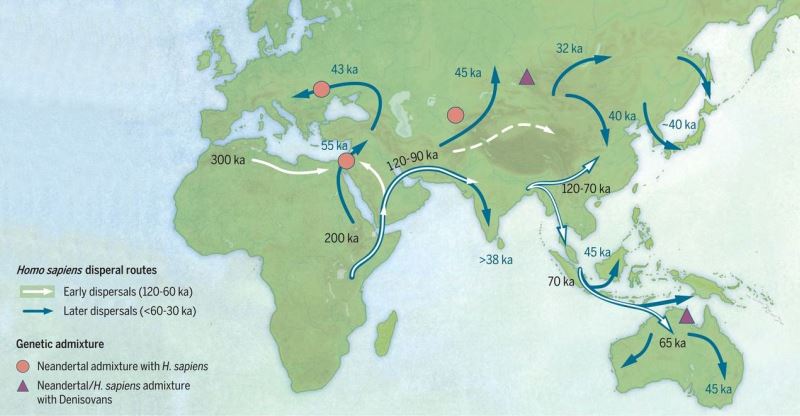
Map of sites with ages and postulated early and later pathways associated with modern humans dispersing across Asia during the Late Pleistocene.
|
|
A legible magnification will appear when the mouse is over the image below. 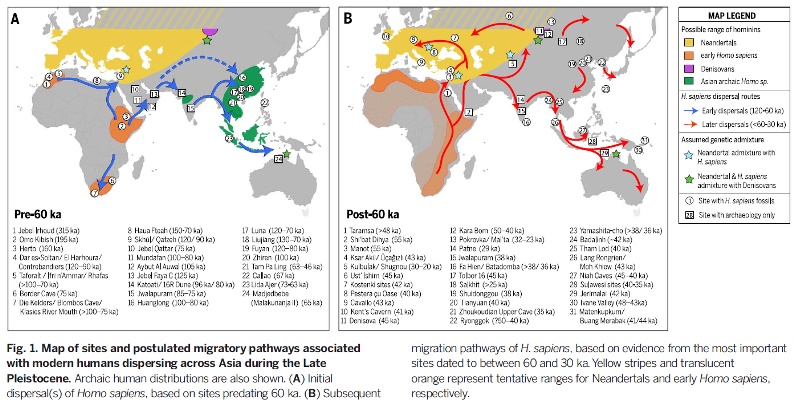
A legible magnification will appear when the mouse is over the image above. |
|
Map of sites and postulated migratory pathways associated with modern humans dispersing across Asia during the Late Pleistocene. Archaic human distributions are also shown. |
|
* The origin of the EuropeansThe first immigration of modern humans A genetic analysis of bone fragments unearthed at an archaeological site near Ranis in central Germany shows conclusively that modern humans — Homo sapiens — had already reached Northern Europe 45,000 years ago, overlapping with Neanderthals for several thousand years before the latter went extinct.
The knowledge about the origins of the current inhabitants of Europe and the history of their precursors is continually improving by the many new DNA research techniques. One of the oldest fossils of anatomically modern humans of Europe is a modern human fossil femur found in 2008 on the banks of the river Irtysh near Ust'-Ishim in western Siberia, dated at about 45,000 years old. His Y-DNA haplogroup is K2a-M2335 and his mt-DNA is R*. (31) An other found settlements from hunter-gatherers is found in Extinctiondorf in Austria. They date from 41,000 BCE. (30) A skeleton was found on the Middle Don River in Russia. This dates from 35,000 BCE. It is named Kostenki 14 and belonged to mt-DNA haplogroup U2* and the Y-DNA haplogroup C1b1-K281*. Subgroups hereof are today seen in the Middle East, in Central, South and Southeast Asia, and in Northern China. He belongs to the Basal Eurasian Population from which both current Europeans and North Asians descend. It contains more Neanderthal DNA, and in longer tracts than present Europeans. This is consistent with the shorter period of time since the last matings. (32) His genome reveals the timing of divergence of Western Eurasians and East Asians to be more than 32,200 BCE; and shows that European genomic structure today dates back to the Upper Paleolithic deriving from a metapopulation that at times stretched from Europe to central Asia. (33) The skin color changes to a lighter variant by genes from the Neanderthals and by natural selection because reduced pigmentation promotes the production of vitamin D and therefore the life chances in the dark North. The final white European colour first appeared in the Neolithic after the arrival of the Anatolian agrarians. (34) In Romania is a find from the Pestera Cu Oasis, from around 39,000 years ago with Y-DNA haplogroup F and mt-DNA haplogroup N. DNA was analysed from a 37,000 to 42,000-year-old modern human from Pestera cu Oase, Romania. They found that about 6,9% of the genome of the Oase individual is derived from Neanderthals, more than any other modern human sequenced to date. (35) Around 39,000 years ago a gigantic volcanic eruption near present-day Napels dropped an estimated three hundred cubic kilometers of ash across Europe, separating archaeological layers preceding it from those that succeeded it. Almost no Neanderthal remains or tools are found above it. Most modern human archaeological cultures that left remains below the ash layer left none above it. Many modern humans disappeared as dramatically as their Neanderthal contemporaries. (36) The Aurignacian CultureA new culture then emerged in Europe called the Aurignacian. The name is derived from the French town Aurignac in the Haute-Garonne, an archaeological location of this culture from the late Paleolithic. This new population filled in the vacant space left by the great aforementioned volcanic disaster. Stone materials found all across Europe, are also found in Belgium in the Trou du Renard (Furfooz, Namur). Finds are from Goyet in Belgium dated from 33,160 to 33,430 BCE, and belonged to Y haplogroup C1a2-Z38842 and mt-DNA haplogroup M. (37) Three anatomical modern humans of Pesteracu Oase cave in Romania are about 33,000 BCE and five individuals from the Mladec cave in the Czech Republic are about 30,000 ybp. (38) Four persons from Sungir in Russia all with C1a2, and five individues from the Mladec grottes in Tsjechia old obout 28,000 years have Y-DNA I-J-K. (39) The people of this culture produced worked bone or antler points and the earliest known cave art, such as the animal engravings at Aldène and the paintings at Chauvet cave in southern France. 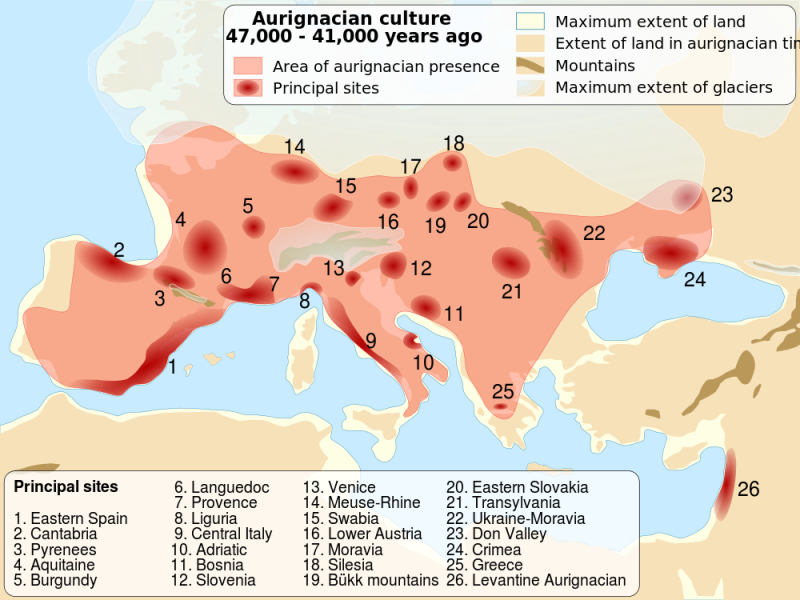
* |
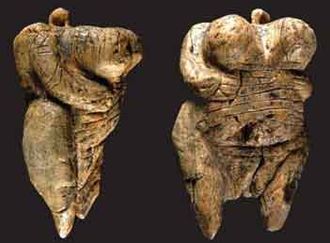
The Venus of Hohle Fels, hewn from mommoth ivory, found in 2008 near Schelklingen, Baden-Württemberg, Germ, dated to between 35,000 and 40,000 BCE. |
The Swabian Alb region has a number of caves that have yielded mammoth-ivory artifacts of the Upper Paleolithic period, totaling about twenty-five items. These include the lion-headed figure of Hohlenstein-Stadel, dated to 38,000 BCE, and an ivory flute found at Geißenklösterle, dated to 40,000 BCE. The "Lion Man" is the oldest known anthropomorphic animal figurine in the world. (40) |
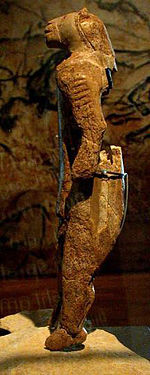
|
Gravettian CultureThe Gravettien Culture is the successor of the Aurignacian and dates from 33,000 to 22,000 years ago. It is named after the site La Gravette near Bayac in the French Dordogne. Reich et al. extracted DNA from Gravettian individuals buried in present-day Belgium, Italy, France, and the Czech Republic. They were all genetically very similar despite their extraordinary geographic dispersal. Analysis indicated that most of their ancestry was derived from a same sublineage of European Hunter-gatherers as before the great Volcano Eruption and that they spread West, displacing the sublineage associated with the Aurigniacan tools. (41) The industry's distinctive stone tool is a small pointed blade with a blunt but straight back, known as the Gravette tip. The most important sites are in Central Europe, Dolní Vestonice and Willendorf. A new people had came in who made new tools. The material remains they left behind include more refined female statuettes, as well as musical instruments and dazzling cave art. They were much more deliberate about burying their dead and as a result we have many more skeletons from this period then we do from the Aurignacian period. The artistic expressions include the often refined "Venus figurines" of stone, bone or clay. The locations are spread over Spain, France, Germany, Austria, Czech Republic and Slovakia. At Dolní Vestonice the Venus statues were not only modeled but also hardened in a fire. A carefully decorated grave was found there, in which a woman of around forty years was laid out, decorated with red ocher. Her shoulder blades were covered with scapula bones of a mammoth, and tools lay with her. Possibly she was a shaman. 
Venus of Brassempouy
In Western and Central Europe the Gravettian was succeeded by the Solutrean and the Magdalenian. |
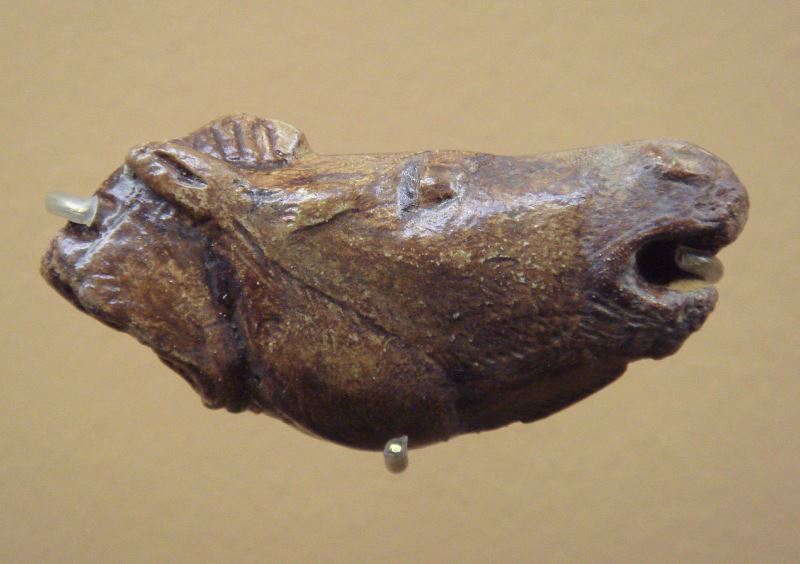
|
The Magdalenian CultureThe Magdalenian is one of the later cultures of the late Palaeolithic in Western Europe. It is named after the site La Madeleine in the Dordogne. This period contains many sites and evidence for the hunting of red deer, horses and other large mammals that occurred in Europe at the end of the ice age. The culture was geographically widespread. There are sites from Portugal to far in Russia. Head of a horse, Magdalenian. |
|
This culture was dated by a skeleton from present-day Spain dating to around 19,000 years ago. Over the next five thousand years they migrated to the Northeast chasing the retreating Ice-sheets into present-day France and Germany. They covered the period from about 19,000 to 10,000 years ago and ended with the end of the ice age. It is characterized by blade industries. Most of the ancestry of the individuals associated with the Magdalenian culture came from the sublineage represented by the thirthy-five-thousand-year old individual from Belgium who is associated with the Aurinacian culture but who was later succeeded at the same site by people who used Gravettian tools and carried DNA simular to others in Europe associated with that culture from Near Eastern origin. The Aurignacian lineage had not died out, but instead had persited in some geographic pockets, possible in Western Europe, before its resurgence at the end of the ice age. A renewal is the microlite (42). The final stages are characterized by the presence of harpoons, made of bone, antlers and ivory. |
|
The Solutrean CultureThe Solutrean ca. 20,000 to 14,500 BCE is also one of the last culture stages of the Late Paleolithic. It is named after the site of a fossil coral reef at Solutré-Pouilly, near Mâcon (Fr). The distribution area included southern France, Spain and Portugal and was a refuge for hunter-gatherers at the time of the Last Ice Age. In South Spain, for example, a site has been excavated (Cueva de Nerja) where many fish, including haddock, had been caught: this species is a species that only exists today in the North Sea, the North Atlantic and the Arctic Ocean. The Solutrean has relatively finely worked, bifacial points made with lithic reduction percussion and pressure flaking rather than cruder flint-knapping. Knapping was done using antler batons, hardwood batons and soft stone hammers. The percussion and pressure-flaking method permitted the working of delicate slivers of flint to make light projectiles and even elaborate barbed and notched arrowheads. Solutrean Kling (Musée des antiquités nationales Saint-Germain-en-Laye) |
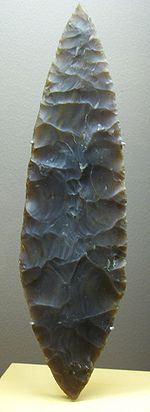
|
|
Large thin spearheads; scrapers with edge not on the side but on the end; flint knives and saws, but all still chipped, not ground or polished; long spear-points, with notch and shoulder on one side only, are also characteristic implements of this industry. Bone and antler were used as well. The caves of Lascaux in France show the already very artistic expressions of the Homo sapiens, our human species. They date from 20,000 to 12,000 years ago. 
Rock drawing of a Cro-Magnon in the Lascaux Caves, France circa 15,000 years ago This last period of the "Ice Age" was a period of climate instability within it the Bølling-Allerød interstadial period a warm period that ran from c. 12,700 to 10,700 BCE. * Mesolithic or Middle Stone AgeNew PopulationThe warming up after the last "Ice Age" started 11,000 BCE. The landscape and the people in it changed rather abruptly. The polar ice rapidly receded north, and the ice caps on the mountains melted. Two thousand years later, the tundra with its reindeer and big game was almost entirely replaced by deciduous forests from the south, which covered the whole of Europe. About 8,000 BCE it was even a bit warmer here than it is now. The very harsh stages of the ice age had caused a genetic bottleneck in Europe. The vast majority of the people that belonged to mtDNA haplogr M drew northwards, following the reindeer. Their haplogroup M is now mainly present in Asia, Australia and America, but is now virtually absent in Europe. (43) Europe was colonized by a new population hunter-gatherers coming from the Near East. They had diverged from the former residual population some 30 millennia earlier. Their skull shape is also something else than the last, and they had still the old mtDNA haplogroup U. (44, 45) Though it may seem strange and counter to our natural suppositions, the biomass of forest mammals is less than a third of the biomass of mammals on the open tundra and steppe. Because this wildlife was smaller and faster, it was more difficult to hunt. These animals could also keep themselves well hidden. Therefore, hunting required new and different tactics and forms of cooperation. This change came too fast for most people of that era and, by the final glacial cold phase, the population was already greatly diminished. A further dramatic population decline followed, reducing both the number of population sites and the number of residents in them, and simplifying the culture of Cro-Magnon man until it finally disappeared. These people lived as they always had, in small family groups who came together to form larger groups of twenty to several hundred persons during some periods in the year. They followed the wandering herds of cattle and knew the places where suitable food could be grown in different seasons. They regularly came together in larger groups to exchange products and establish contacts, to marry and to observe ritual celebrations. It was an egalitarian society. Only later did different social strata emerge, as is evidenced by differences in burial gifts and precious goods in some children's graves. This was certainly the case when the wealthier graves were located together. Some cemeteries also contained groups of graves with similar objects, which may indicate different social classes or ethnic groups. |
|
It is noteworthy that dogs had a high position. They were often buried with their master and some had even their own graves with rich burial goods. However this dog, buried in Alblasserwaard (present-day Holland), had nothing, at least nothing that endured through time. (46) Dog Grave |
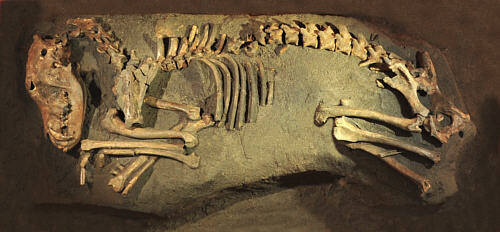
|
|
* In the Near EastIn a region in the Near East, the so called Fertile Crescent, lived hunter-gatherers. They roamed this area that was rich in fruits and game. There is still no trace of permanent occupation. The two best known groups are the the Baradostian, 24,000 – 18,000 BCE of the Zagros Mountains of western Iran and the Levanto-Aurignacian, 27,000 – 18,000 BCE in the Levant. Here people lived with the Y-DNA haplogroup C-V20, in a find dated to 15,000 years ago. G was already split in the first subgroups, G1 especially in the eastern part, G2 in the central and western part. In the Fertile Crescent these populations evolved gradually to a proto-agrarian semi-sedentary society. In the warm and moist Bølling-Allerød interstadial, 12,700 to 10,700 BCE was a rapid population growth and they lived together in a population in a Pre-Pottery Neolithic Culture. In the southern part of the Levant a special society is formed, the Natufians (12,000-9,500 BCE). Their culture rooted in the preceding Kebaran. They had a rather dark skin and had the Y-DNA haplogroup E. They lived when the Magdalene lived in Europe who had drove the Hamburg hunters northward to the Icerrim. The Natufiers extended southward to the Negev desert and northward to the northern part of the fertile crescent. They were hunters and nomads but also had dwelling places with fixed huts, which sometimes contained 100 kg heavy basalt mortars and pestles in which they processed the wild cereals to flour. In the graves we see utensils and jewelry such as Mediterranean shells and pierced teeth and stones, and sometimes a dog skeleton. The cold dry young Dryas intermezzo (10,500 to 9,500 BCE) ended the early phase of the Natufiers. The system of large residences breaks apart and they switched to a mobile and distributed living mode in small units * Neolithic or New Stone Age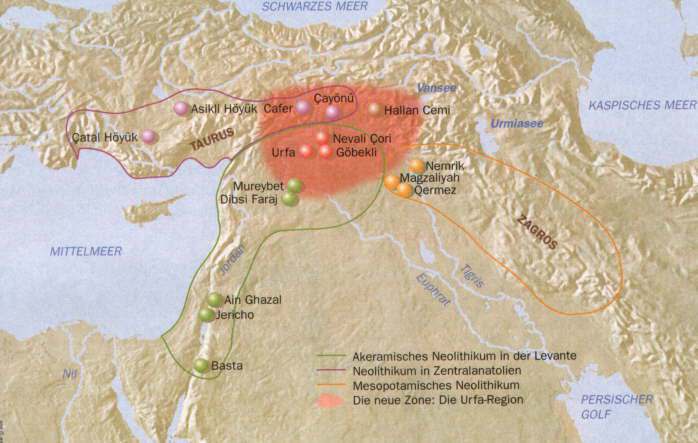
The craddle of Farming in the World. (47) The early days of the Neolithic from 11,700 to 8,800 years agoAfter the 1000 year long cold young Dryas, around 11,700 BP, it appears that the old knowledge has been preserved and also passed on. The wheat fields are again exploited by the Natufians as at Jericho and Abu Hureyra. Population concentrations are now larger than ever with up to 500 residents. Elsewhere in the fertile Crescent, a remarkable amount of cultural diversity will soon emerge. Grain silos are built and a wall is built around the Jericho of that time. Jericho would then be the oldest city in the world. About 12,000-11,000 years ago, pottery started here as well. The first urban society was in Göbekli Tepe around 11,550 years ago (9500 BCE). This was probably a holy place where their first shrines and houses stood. About 9,800 ago, the first cultivated bucket grain appears. The archaeological-botanical remains of Boncuklu Höyük in western Anatolia of Çatal Höyük in southern Anatolia in Turkey and of Chogha Golan in the Zagros Mountains of western Iran are the oldest examples of long-term agricultural cultures. In the north of the Fertile Crescent between 10,500 and 9,500 BP the domestication of the four later farm animals began, sheep, goat, pig and beef. * The first pottery 8,800 years ago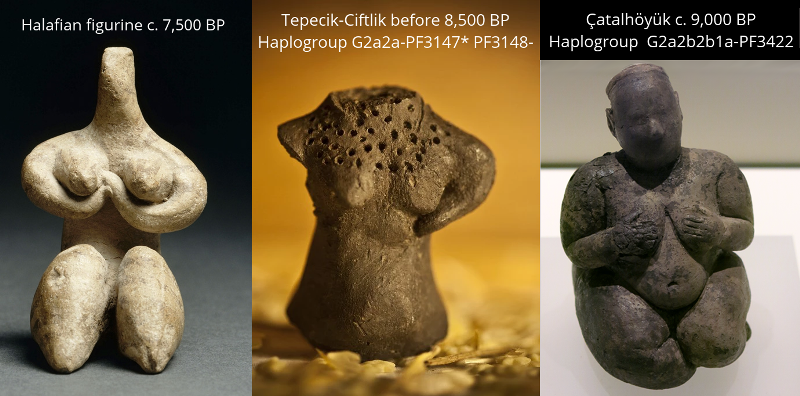
"Fertile Female Figures" of the Halaf Culture c. 7,500 BP, Tepecik-Ciftlik 8,500 BP and from Çatalhöyük c. 9,000 BP. The first pottery is found in Anatolia at Çatal Höyük and is dated to 9000 BP and in Saby Abyad to the Euphrates at 8800 BP. Over the following centuries, we see it appearing all over the region. These are good quality earthenware bowls, painted with simple parallel lines in red and black, but also simple, rather coarsely made, red fired pots for general use. Çatal Höyük provides a detailed picture of the changes that occur over time. Before 8500 BP there is contiguous building, which is seen as a high degree of cohesion, but after that the building breaks down into a large number of smaller units, separated by open spaces, indicating a shift in collectivity to individual households. At the same time, the number of inhabitants in the old settlement decreases, but new settlements are founded in the plain. In the Levant, the same thing happened several centuries earlier. There, this change is related to the emergence of an intensive mixed farming business, which was created by combining arable farming and livestock farming. As a result, the yields increased and the population grew, while more space was taken up per household. Enterprising children involved new branches Leaving the RegionThe population left the region and migrated in all directions, The most western groups went westward to Europe, the eastern groups in the Zagros went eastward to central and southern Asia and northward to the Caucasus and the Russian steppes, southward to the Arabian peninsula and back to Africa to Egypt and Libya and probably already then to Morocco. They took with them seed and their livestock. The beginning of expansion to Europe was already before 4,500 BCE to three regions: the lake area in the south of Antalya, the Aegean coast on both sides of the Aegean sea, and in the Northwest around the Marmara Sea at Barcin. In these regions the G2a2a and the G2a2b groups lived still together and from here they entered Europe about 8000 BCE and they did that through two different routes, one by sea, the Mediterranean group and one across the country, the continental group. The spread of the Neolithic population across Europe has taken over two different paths. A. The Maritime groupThe Cardial ware culture. They go from the Aegean sea region along the coasts of Anatolia and the Levant to Cyprus and Crete. Their pottery is decorated with impressions of various spatulas in simple geometric motifs. It is called Impresso culture in the Aegean region and in the Levant. On Corfu their pottery produces a variant called Impressa. This one is going to dominate. From the West Coast of the Balkans they cross in 8,200 BP to Italy. In this phase their pottery becomes more diverse and decorated with more complex motifs applied exclusively with the cockle shell, cardium edule this we call the Cardium culture. The expansion continues unabated, reaching Portugal around 7,500 BP via the Spanish coasts. The spread took place in leaps and bounds with the construction of clusters of settlements in the Mediterranean coastal plains. Between 7,500 and 7,200 BP farmers and hunters lived side by side there. The farmers in the plains, the hunters around them in the hills. Half of the food of the hunters and fishermen comes from the sea, that of the farmers mainly from the cultivated land. |
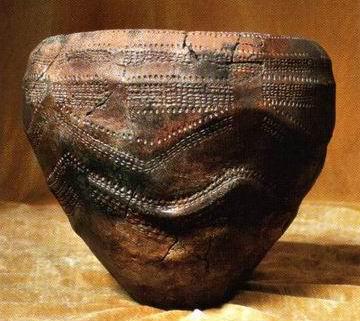
Hoguette culture, 5000-4500 BCE (48) |
From Corfu they colonized the coasts and islands, such as Corsica and Sardinia, as well as the interior over the course of seven centuries. A group headed north in France along the Rhône and Loire to the French Atlantic coast. In Normandy, at La Hoguette is the first identified site of their culture. Most of the sites of this group are found along the Upper Rhine and Neckar, as well as in the Weser Mountains, the Netherlands and in their plausible course along the Rhône corridor. They meet in the Hespenland or La Hesbaye and perhaps also in South Limburg the continental LBK branch. Both groups may have arrived there at the same time. (49) |
|
They arrived in England about 6000 years ago. The genetic relationship of the British and Iberian Neolithic populations indicates that most of the ancestors of the British Neolithic peoplesg were Anatolian farmers who had followed the Mediterranean route and thus entered Britain along the European coastal regions. (50) B. The Continental groupThey are the carriers of the LBK Culture culture. |
|
The very earliest Neolithic Farmers entered Europe at Revenia in Greece around 6,600 BCE. They went through Macedonia to Serbia and Bulgaria through the valleys of the Morava and Danube to Hungary. With stone chisels and axes with a horizontal blade, the farmers cut down parts of the forest to produce their fields. Here the first wheats as emmer and einkorn were cultivated, and the oilseeds linseed and poppy seeds. This mainly happened on the Loess soils. |
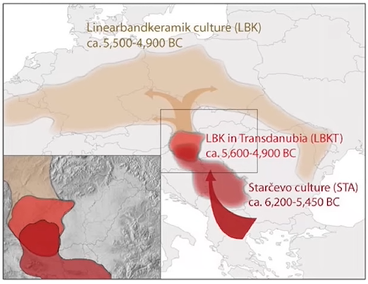
Streams of Neolithisation in Western Europe. (49a) |
|
They reach the Hungarian plain about 5,800 BCE. Here are many archaeological finds of them, they continue along the Danube and the Rhine to Western Europe. They reached Germany around 5,500 BCE and Belgium and the North of France 5,200 BCE. By the characteristic decorations of their pottery this is called the Linear Band Culture, LBK. However, large parts of the Loess areas in Belgium and South Limburg have remained devoid of LBK habitation and this also applies to Northern France, which at that time had no habitation at all, with the exception of course of the hunter-gatherers. (51) L.B.K. CultureSeveral technologically distinguishable pottery traditions with different geographical distributions were developed contemporaneously to the Earliest LBK, 5400–5250 cal. BCE, and existed for centuries in western Central Europe side by side with the LBK and even later in Villeneuve-St. Germain (VSG) contexts after the transition from Rubané (the French LBK) to VSG around 4900 BCE. The Linear bandkeramik (LBK), flourishing about 5500-4500 BCE in Germany and Italy, the Rössen Culture (RSC) flourishing about The majority of the Early Neolithic Farmers in central Europe was a mixture of G2a2a-PF3147 and G2a2b-l30. This is found in a number of consecutive Neolithic cultures, see for this haplogroup G-M201. NON-LBK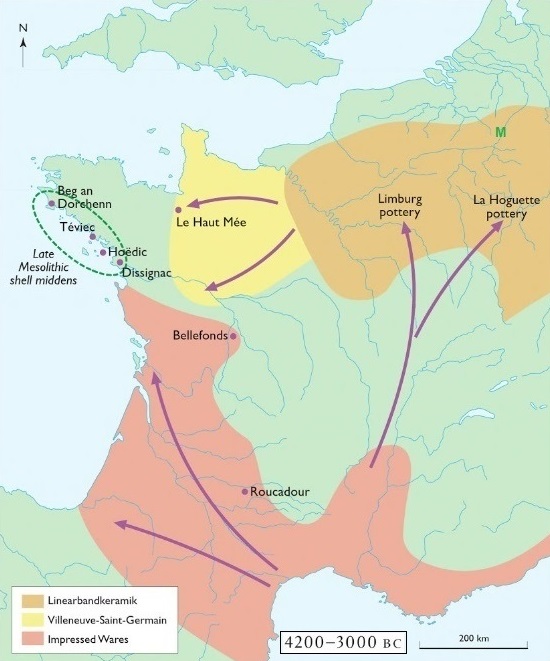
spread potterie, 4200 - 3000 BCE (Cunliffe, 2013). Based on differences in decoration, the early pottery is divided in LBK and Non-LBK pottery. The Non-LBK was divided into the La Hoguette Pottery and the Limburg Pottery style. These styles exist in parallel to LBK, but are different (Constantin, 1985; Jeunesse, 1986; Modderman, 1970). The La Hoguette has features of the Southern French and Eastern Spanish pottery. A West-Mediterranean background is assumed. (52) Limburg PotteryThis is probably the oldest pottery in western Central Europe. The persistent mutual influencing is a key for understanding the development of Non-LBK pottery, as well as for innovations within LBK ceramic production. The Limburg pottery group can be subdivided into a Rhine-Meuse group and a Seine-Scheldt group and are is located in the LBK and La Hoguette area. At least 119 sites of Limburg pottery are known. In the Graetheide LBK settlement cluster, Geleen-Janskamperveld is of particular interest as an early site west of the Rhine, mainly occupied in the Flomborn period, the neighbouring site of Maastricht-Klinkers proves the diversity of Limburg pottery during all periods. (53) In the first settlements in the Maas valley, as in Elsloo, we see the emergence of a unified stroke decoration in mineral-tempered Non-LBK pottery (Modderman, 1981). This then expands across all Non-LBK pottery traditions, even across technological borders, and is distributed from Hainaut to the Rhine, for example in Rosmeer, Aubechies, Weiler-la-Tour Holzdreisch, and Ay-sur-Moselle. In the literature, it is called the “Christmas tree decoration” and constitutes up to 40% of Limburg pottery. It perhaps expresses an identity explicitly opposed to the LBK. (54) In southern Limburg, the Hesbaye and Condroz, the Limburg culture flourishes from 5,500 BCE. They meet the Hoguettians here. Through Lorraine, a branch went through the basin of Paris to the Channel and Hainaut. Through exchange within a wide network, farmers knew to obtain raw materials from distant regions, such as hematite, an iron oxide that they used to polish pottery and for the red color, and the hard black amphibolite from which they made adzes. 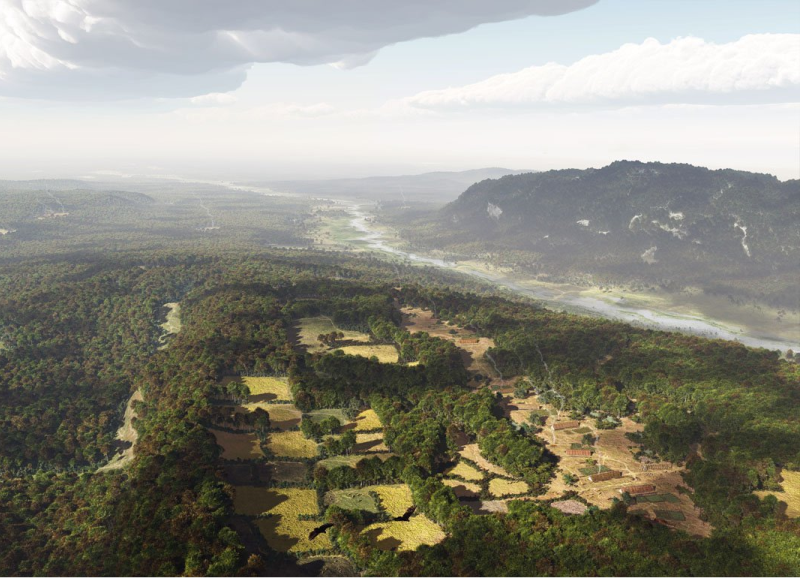
Reconstruction of a LBK village on the Cannerberg at Maastricht. The LBK started in Limburg around 5,350 BCE and did not last longer than 230 years. Before the year 5,000 BCE it was already over. (54) In a short time the society had changed completely. Settlements arose in the form of several hamlets from three to five houses. These houses had a wooden frame with wattle walls covered with loess, such as in Caberg at Maastricht. The dead were buried in joint cemeteries, some of them were burned others unburned, and they lied close to each other, with gifts in their grave. From 5,000 BCE, the pottery has two shapes. The famous Limburg pottery is quite soft and has open bowls with the typical zigzag straps. The La Hoguette pottery, named after the first location in Normandy, is found across the Rhine and also in our country at Kessel and Sweikhuizen; It is harder and egg-shaped and has a pointed bottom. Until the end, these two cultures flourished side by side. (55) PhysiqueThe farmers mainly ate cereal products and vegetables, and only small amounts of meat from their livestock. As a result, they were less healthy than the hunter-gatherers. Their teeth were worse, they were also smaller. There was a rapid population growth with the farmers, but with the hunter collectors this is not observed. For Germany a population growth has been calculated from 8000 people at the beginning to 250,000 at the end of the LBK, a growth of 25% per generation. When all of Europe was colonized a stable situation emerged, but soon fortifications show competition over land. Shortly after we witness massacres. The next stages of the LBK are characterized in particular in the west by increasing internal violence, most likely between related groups. It seems that robberies developed into a real plague and ultimately led to a disruption of the society through women's robbery, loss of lives, disturbance of harvests or loss of livestock Mass killings take place because of too many people and to little food. There were two types of massacres. One where the whole community was killed and the land was taken, the other type of killing where alone the men were killed and the women were taken away for reproduction and labor. Eventually people leave their settlements. Then they mixed with the hunter-gatherers also because they were so strong and large. HaspengouwIn the Haspengouw and South Limburg the settlements at the end became smaller and then broke down altogether shortly after 5,000 BCE. Then followed a short gap where the old fields were overgrown. It is unclear where the people stayed thereafter. There is no idea about the causes. The society became divided into a number of separate cultural areas, each with their own pottery style, as well as own innovations, such as in the form of axles and housing constructions. Based on the rapid and abrupt changes has been suggested that there was a crisis by internal causes such as soil depletion together with rapid population growth. An argument against this is that the loess soils are very fertile. Due to population growth territorial conflicts may have been a cause. There may have been external causes, for example a serious large-scale epidemic. Or a combination of these. 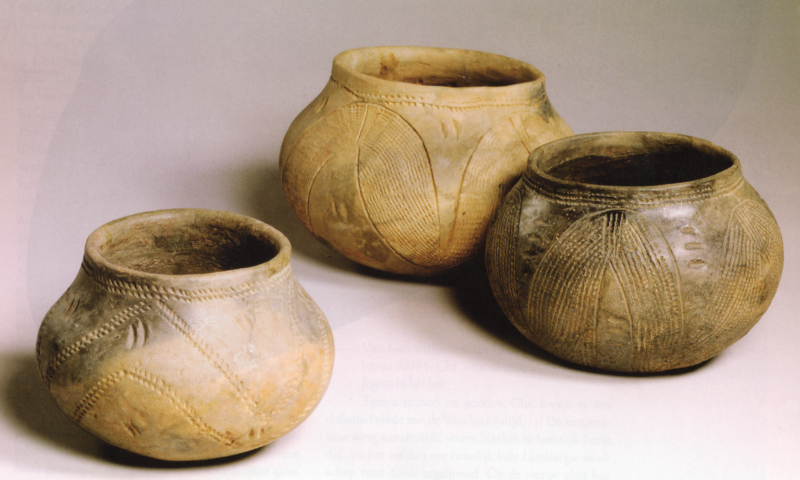
Linear Band Ceramic pottery from Limburg, the National Museum of Antiquities, Leiden, Netherlands |
|
The agricultural tradition and the wide exchange network for specific commodities was restored not long after the loss of the LBK by farmers of the Rössen culture, 4,500 to 4,000 BCE such as in Maastricht to Randwijk. The Rössen vessels are characteristically decorated with double incisions "goat's foot incision". They are best known for their Breitkeile, massive pole axes of stone, which apparently formed a popular export item. They are found in Southern Germany, far beyond Limburg. This was followed by the Michelsberg culture, 4,400 to 4,500 BCE. It is a collective name of a large number of related communities, known by their Funnel beakers. |
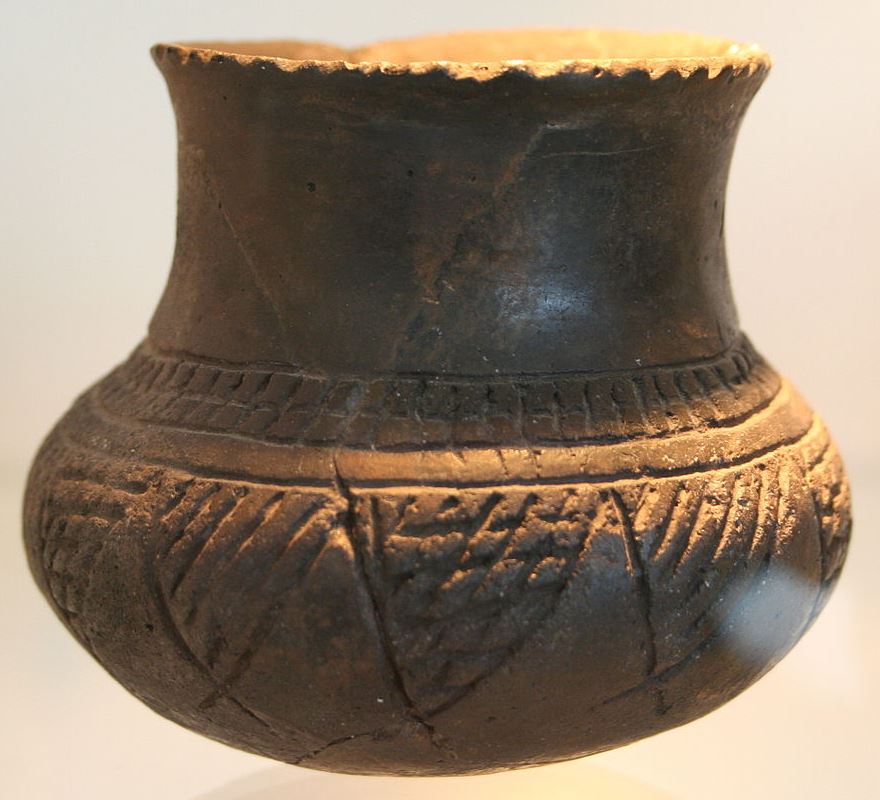
Kugelbecher der Rössener Kultur (56) |
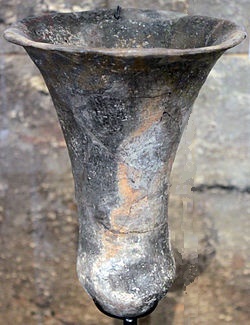
|
They lived in the area from southern Scandinavia in the north, the Netherlands to the west, the Danube in the south. In the southeast there was partly an overlap with Lengyel culture. They are the Hunebed builders of Drenthe in the Netherlands. Their residences usually lie on hilltops and have the impression to have been fortified settlements, indicating restless times. Along the Meuse are found hundreds of sites of their pottery and flint remains. Their residences have been simple because we hardly find relics, but they left the first still visible traces in the Limburg landscape in the form of flint mines, such as in Rijckholt-St Geertruid and Valkenburg. The gray flint blocks were collected to a depth of 12 meters from the limestone. With deer horns and flint hoes, operators dug an extensive system of deep mine shafts. |
|
* Megalithic SocietiesMegaliths in Northern Germany as also in the Netherlands developed within the Northern Funnel Beaker societies. Its people were probably descended from farmers migrating into Central Europe out of Iberia and modern-day France, who in turn were descended from farmers of the Cardial Ware cultures who had migrated westwards from the Balkans along the Mediterranean coast. Connections between the Funnelbeakers and these farmers of the Atlantic coast is supported by genetic evidence. This genetic evidence is based on mt-DNA and a-DNA. Not on Y-DNA because only the old male haplogroup I is found, but no G is reported. (57a) 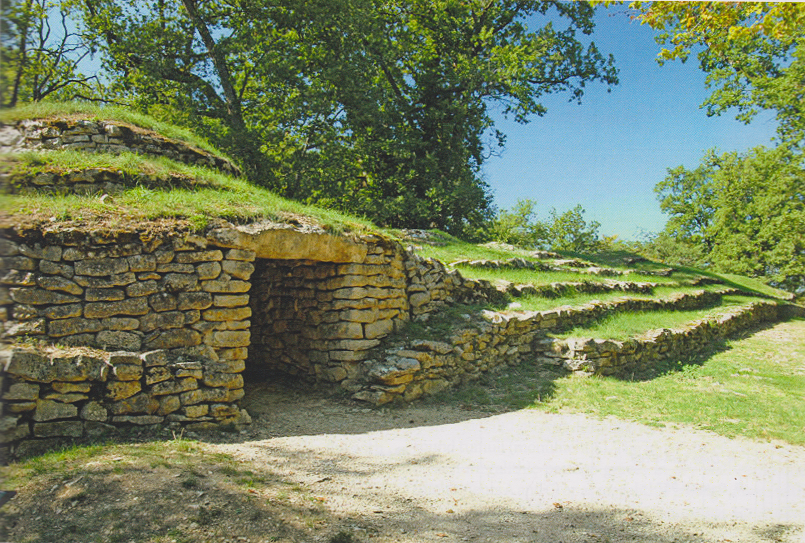
Tumulus and passage grave, Chiron-Bougon (fr) (57) Megaliths (μεγαλιθοσ in old Greek is big stone) include stone tombs, standing stones, stone circles, alignments, even buildings or temples. They are found in Europe, North and West Afrika, the near East, Asia and North and South America. In Europe more than 35.000 objects are found and they resent surely just a small part of the original number. In Europe they are found in the western coast regions in Southern Portugal, Northern Spain, Northwest France, Great Britain, Scandinavia, North Germany, the Netherlands, Belgium, and in Russia in the Ural and the Caucasus. In Africa in Mzoura, Morocco, is Megalithic Circle consisting of one hundred and sixty-seven standing stones forming a circle with a diameter of around sixty meters. Locals believe that it was the grave of a Mauritanian king dating back to around 3000 BCE, but this has never been proven. Some researchers point to the distinctive similarities between the stone circle of Mzoura and megalithic sites found in Britain, France and Ireland, suggesting those sites and the Moroccan site were erected by a group with the same cultural beliefs. Strikingly is the appearance and the architectonic concepts are similar or even identical. Throughout the mentioned geographical areas megalithic graves were built as dolmens and as graves. Erected stones stand either isolated in the landscapes or were arranged as circles or rows. Furthermore, there is evidence all over Europe for an orientation of the graves towards the east or southeast in the direction of the rising son. Montelius (1889) was the first to mention the Orient as cradle of the megalithic culture. Gordon Childe (1925) incorporated the idea of a diffusion of an oriental religion along the coastline over the sea route. Due to a certain prestige status, the megalithic culture coincides with the prospection for copper (Daniel 1960) and gemstones as jadeite and variscite in Europe (Schulz Paulsson, 2017). Thus in building and planning of these megaliths represent well-organized, communal endeavours. Megalith-builders formed perhaps a spiritual and over far distances trading aristocracy. Johannes Müller (1999) defined the chronology of the different megalithic grave forms for Europe based on carbon dates. He determined two or three centers of origin for European megaliths: the Western Iberian Peninsula, North West France, and possible Ireland with passage graves and dolmens from 5000 cal. BCE onwards. The megalithic grave tradition spreads from there to the back lands of France to Southern Ireland, Scotland and England. A systematic survey was carried out of a 50 km2 sector in Lagos, Algarve, Portugal. Seventeen sites with standing stones were decorated with recurring symbols. All the groups of standing stones seemed to be linked to settlements with an artefact set dating an age of 7983 and 7203 BCE, these standing stones started to be erected before the first existing evidences of cereal agriculture in the area. Moreover, the dispersion of the settlement sites, standing stones and symbols, allows the interpretation of patterns of the social organization of the menhir-makers with evidence and detail not previously possible for a European prehistoric society. (Gomes & Cabrita 1997, Calado 2000, Nocete 2001). Furthermore, the surface surveys document the absence or extreme rarity of prehistoric pottery in some standing stones settlement sites. (58) The earliest monumental, but non-megalithic funeral architecture in Northwest France and in all of Europe emerges in the Passy graves in the Paris basin and with the necropolis Passy, which dates at the latest from ~4960 BCE onwards. These graves have no megalithic chamber yet. These monuments are impressive and monumental structures with a length of up to 280 m and and contained single or few burials, maximal one one burial per generation is calculated based on the carbon results. The implication of this argument might support the conclusion that the Passy graves were the burial sites of for a selected part of the Passy societies such as the religious or social elite. Grave goods added in four graves included ceramics, a flint arrowhead, several chalk pearls and one variscite pearl. There is also evidence of ochre. (Billard/Degobertière 2007) Some centuries later the first monumental Megalithic graves are built in the North and Central West of France, Brittany and Normandy, and especially in the region Carnac. (Renfrew 1973, Joussaume 1985, Laporte 2002). The earliest burial in La Sablonnière is calculated 5091-4858 BCE and in the neighbouring Le Richebourg is calculated 4056-4856 BCE. In Brittany i.e. Carnac pit burials were covered by a mount. These emerge somewhat later than the structures in the Paris Basin. ~4680 cal BCE. Morbihan can be seen as a central region regarding the Megalithic proliferation in Europe. Radiocarbon dates from the Netherlands, Northwest Germany, Denmark and Scandinavia suggest the beginning of megalithic architecture in these regions shortly before 3400 cal BCE. and in the Mediterranean even later, with Catalonia as a possible exception. Four megalithic graves and a few dozen standing stones, a small part of the original corpus remained in Belgium. They are in the region Namur and Luxembourg. Radiocarbon results from human bone samples are from ~2840 BCE (Toussaint et al. 2002) Megaliths in Northern Germany as also in the Netherlands developed within the Northern Funnel Beaker societies. The dolmens were constructed as simple ancient non-accessible dolmens, the so-called Ur-dolmen. In the Provence the emergence is from a later time span ~3310 cal BCE. In Brittany they call it a Menhir or a Dolmen, in the Netherlands Hunebed. The oldest in the Netherlands dates back 4,300 years ago. In England, these Burial Chambers were built for the first time a thousand years later. Sometimes they are arranged in circles; in Wales they are called Cromlech, in England Stone circle and Henge. If they occur in groups, the British call them a Cairn (59). The dolmens in the Caucasus in Russia are from at least 3250 BCE, placing them roughly in line with tail end of the Neolithic in the western Caucasus and the beginning of the Proto-Colchian culture in the Lowlands. 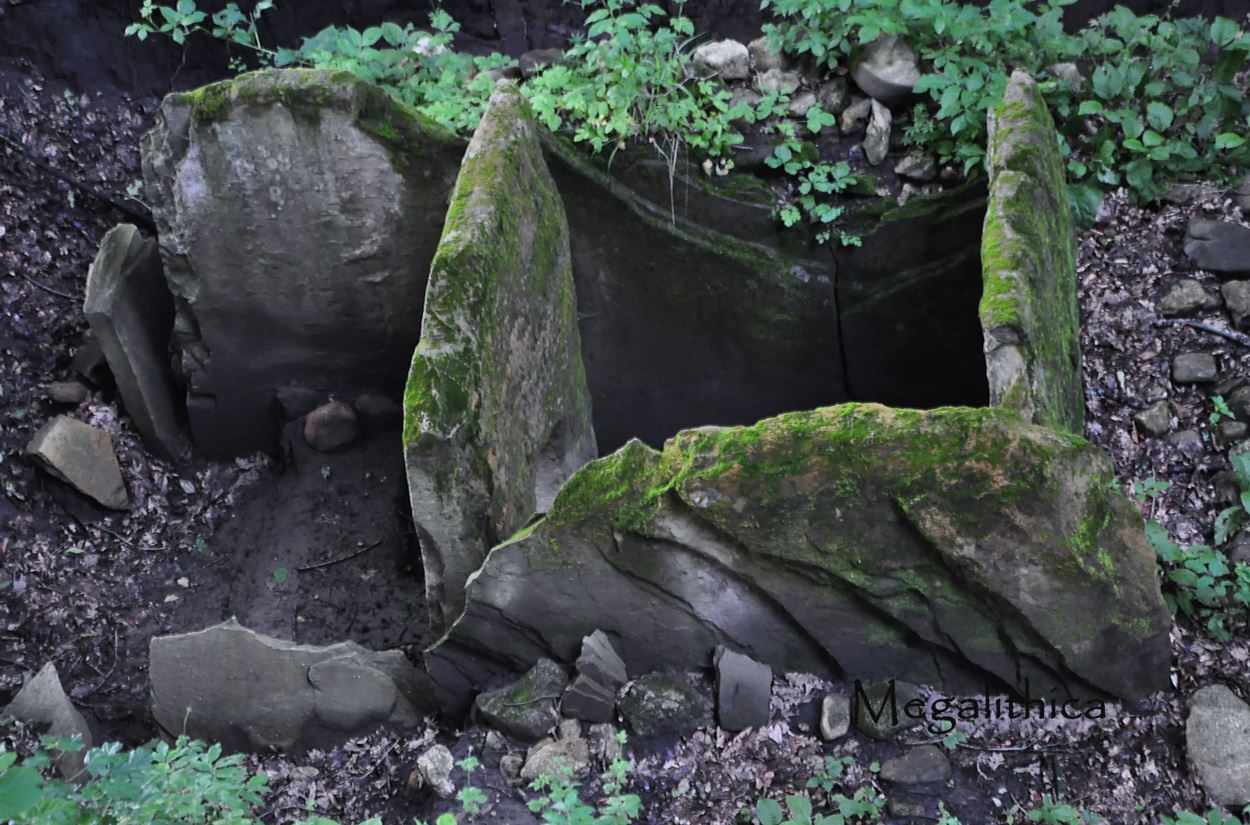
Dolmen in the Western Caucasus 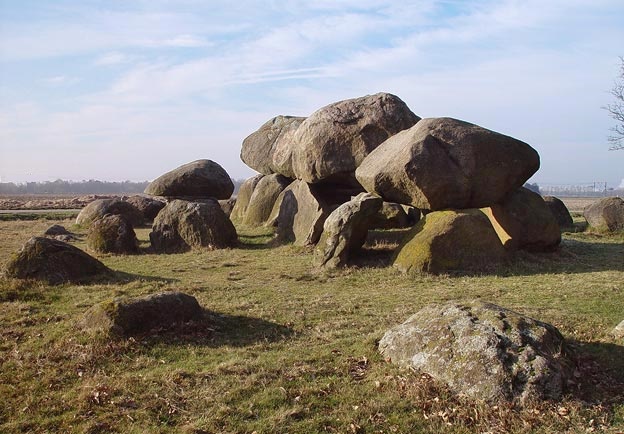
A Dutch Hunebed 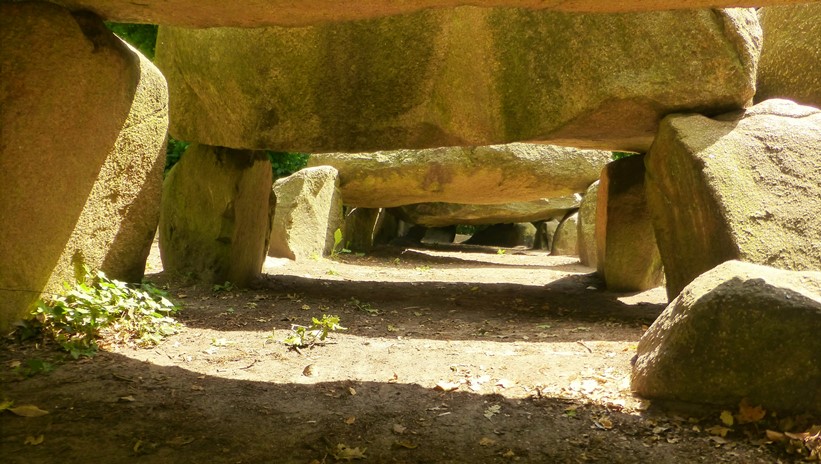
Under a Dutch Hunebed 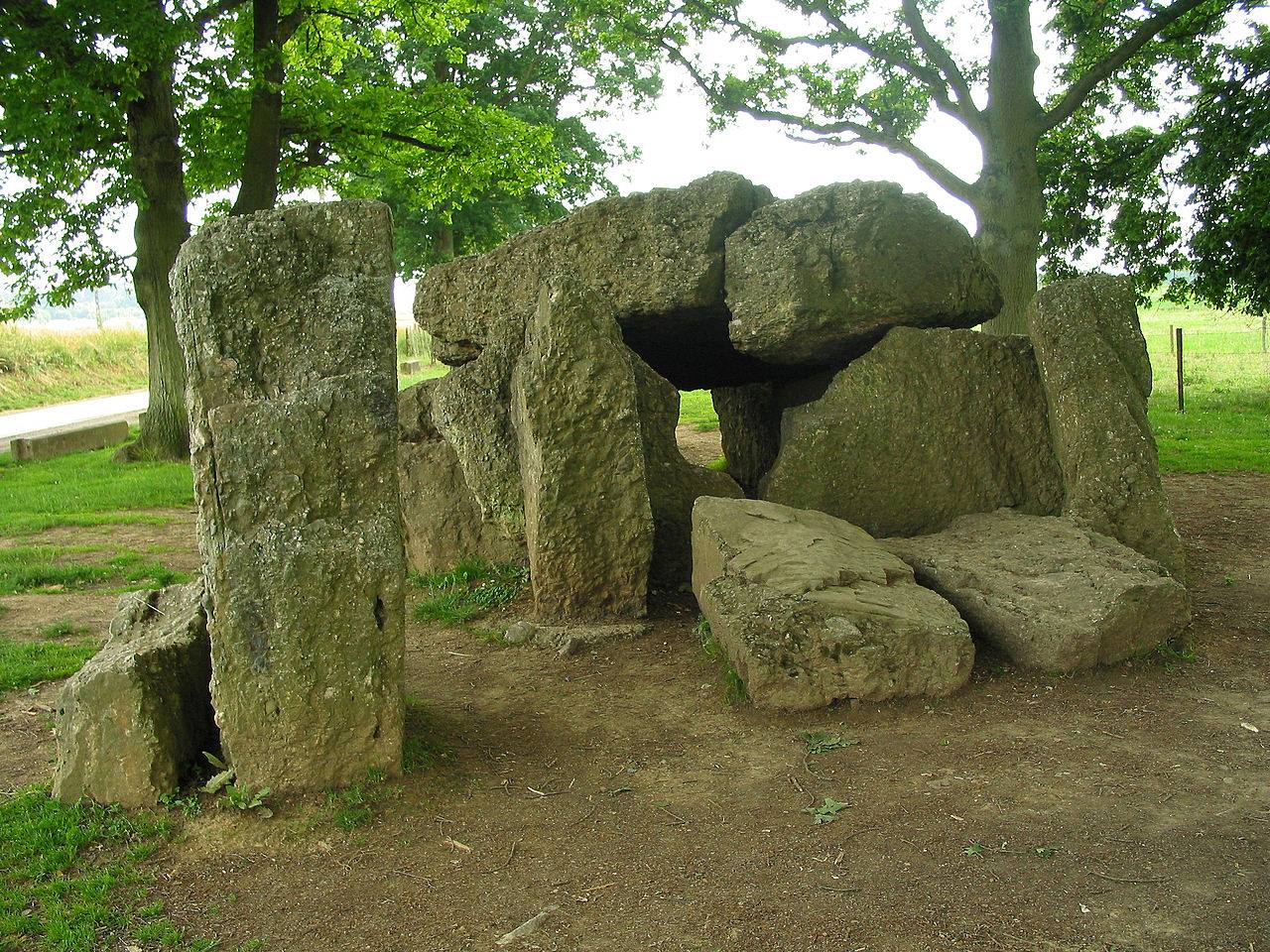
Megalithic field in Wéris, municipality of Durbuy, Belgium With 17 standing stones and two covered alleyways, spread over a length of eight kilometres. These dolmens are about 4,800 to 5,000 years old, which means that they are not as old as the Dutch hunebeds. They were built during what we call the New Stone Age by people who belonged to what archaeologists refer to as the Seine-Oise-Marne Culture. The heart of this culture was in the Paris Basin, but there were offshoots as far north as the valleys of the Maas and the Sambre and into today’s Flanders and the south of the Netherlands and thought to be used as a burial site, as indicated by the discovery of the remains of fires, animal and human bones, and pottery sherds from the Funnel Beaker Culture . (60) It is striking that their settlements showed an increase in defensive measures. Notable are the many finds of skeletons that are buried very disorderly, so it seems that that these many people died a violent death. This indicates a violent end of this era. (60a) * The Copper AgeThe Carpathians, in the Northern Balkans, are rich in copper. The first copper ore was mined in where now is Serbia and Hungary from 5,400 to 3,800 BCE. The first copper weapons, tools and jewelry were made there. This time is therefore called the Copper age or The Chalcolithic period. A century later the first gold was melted and processed in present Bulgaria. This was traded over long distances en is found in the former pastoralist societies in the southern Russian steppe and in the cultural flourishing Asia Minor. * Y-DNA in the time of the LBK and Cardial ware Culture in EuropeG2a people may have been the first modern humans who had acquired the alleles for fair skin. This is seen in an Early Neolithic farmer from Germany who possessed the same alleles for fair skin as the modern Europeans nowadays, while in an archaeologic found of a G2b man in the from Wezmeh Cave in Zagros, Iran, who was from ± 7,250 BCE, this was far lesser. He had a relatively light skin and black hair, contemporaries in this region were also partly light, partly medium tinted. A hunter-gatherer from northern Spain as recently as 5,000 BCE, tested by Olalde et al. 2014, was still dark skinned. But an early Neolithic farmer from Germany possessed also the same alleles for a white skin as found in modern Europeans. (62) Early Aegean farmers dating to ± 6,500-6,000 BCE are the main ancestors of early European farmers. The majority of the Early Neolithic Farmers in central Europe was a mixture of G2a2a-PF3147 and G2a2b-l30. This is found in a number of consecutive Neolithic cultures, see for this haplogroup G-M201. (63) They all have in common that about half of their ancestry comes from another "Basal Eurasian" lineage with little or no Neanderthal admixture. These two lines had separated more than 50,000-60,000 BCE, around the time they left Africa. (64) Around 3000 BCE, the farmers in Europe had acquired quite a few genes from the population of hunter-gatherers, far more than their ancestors in Anatolia had. This clearly coincides with a degree of knowledge transfer from the residential population with haplogroup I to the new population of farmers, such as the use of stone types, obsidian from the Zemplén or Tokaj Mountains and radiolite, a kind of flint, from the Bakony Hills at Lake Balaton. Also a demonstrable part of their food is now also from hunting. Y-DNA G2a was present in the majority of the Y lines of this population, together with the Mt-DNA K1a12a and X2. This genetic picture remained broadly the same until the Bronze Age. The Mesolithic European Haplogroups are C, F and I. Some I1, most with haplogroup I1a1-P37, and also I2 lineages of hunter-gatherers assimilated with the Near Eastern farmers who had made their way into Europe across the Balkans and the Mediterranean shores. In the burial grounds in Starčevo and the Hungarian Plane is found the first European G2a with the subgroups G2a2a-PF3147, including G-L91 and G2a2b-L30. Two-thirds had a G clade. (65) Neolithic individuals from Northwest Anatolia from about 8300 years ago show genetically a homogeneous society with a strong resemblance to the first farmers in Europe. They have the same high percentage G2a that in composition is similar to that of the first European farmers, they have a strong genetic (autosomal) relationship. This indicates the now accepted origin of the first European farmers from this area. British Neolithic farmers were genetically similar to contemporary populations in continental Europe and in particular to Neolithic Iberians, inhabitants of the east coast of Spain, suggesting that a portion of the farmer ancestry in Britain came from the Mediterranean rather than the Danuban route of farming expansion. (66) The European farmers with haplogroup G had in the beginning very little admixtures with the indigenous European hunter-gatherers with haplogroup I. Such a picture we see also in the Anatolians. They felt superior, they felt civilised, the hunter-gatherers were 'barbarians'. They traded with each other, but both didn't want to become like the other. From the fifth millennium farmers and hunter-gatherers started to mix. (65a) * De Yamnaya Culture of de South Russian steppesIn the Pontic-Caspian Steppes of South Russia existed a nomadic culture where also some agriculture was practiced. Characteristic of the culture are the burials in (Yamna) (ЯМЬӀ), pit graves in kurgans (tumuli), the corpse buried with bent knees lying backwards. The bodies were covered with ochre. The Yamnaya culture dates from the period of the transition from Copper Age to Bronze Age, about 3.600 to 2.300 BCE. They were settled between the Bow, Dniester and the Urals. Hill forts have here been found. The Yamnaya were speakers of proto-Indo-European, but thought not to have invented it. (61) They were were cattle-breeding nomads and the first users of wheeled vehicles pulled by horses. They buried their dead in pits, sometimes covered with mounds, that shows their social status. They hardened their copper to bronze. They started to melt iron from the rocks forming it into utensils and weapons. (67) The Corded Ware culture is thought to have originated from the westward migration of Yamnaya-related people from the steppe-forest zone into the territory of late Neolithic European cultures such as the Funnel beaker cultures (69) and is considered to be a likely vector for the spread of many of the Indo-European languages in Europe and Asia. Corded Ware culture encompassed a vast area in south Central Europe, from the Rhine in the west to the Volga in the east, occupying parts of Northern Europe, Central Europe and Eastern Europe. (68) * A new population in Europe
|
|
Beginning around 2,700 BCE a couple of centuries after the Corded Ware culture swept into central Europe, there was an even more dramatic expansion of the Bell Beaker Culture, probably from the region of present-day Iberia. DNA shows that individuals in Iberia were genetically indistinguishable from the people who had preceded them. Once the Bell Beaker culture reached central Europe through the dispersal of ideas, it spread further through migration. Prior to the spread of Beaker culture into Britain, not a single ancient DNA sample from among the many dozen Reich c.s. analysed, had any steppe ancestry. But after 3,400 BCE, each one of the many dozens of ancient British samples they analysed had large amounts of steppe ancestry and no affinity to Iberians at all. |
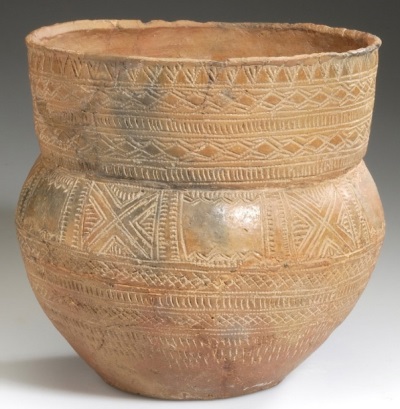
Dutch Bell beaker (79) |
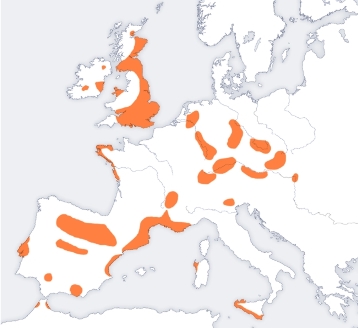
Bell Beaker map (80) |
Measured in terms of its proportion of steppe ancestry, DNA extracted from dozens of Bell Beaker skeletons in Britain closely matches that of skeletons of Bell Beakers culture graves across the English Channel. The genetic impact of the spread of peoples from the continent into the British Isles in this period was permanent. British and Irish skeletons from the Bronze Age that followed the Beaker period had at most around 10 percent ancestry from the first farmers of these islands, with the other 90 percent from people like those associated with the Bell Beaker culture in the Netherlands. This was a population replacement that was as dramatic as the one that accompanied the spread of the Corded Ware culture. (81) |
|
The spread of the Beaker complex introduced high levels of steppe-related ancestry and was associated with the replacement of approximately 90% of Britain’s gene pool within a few hundred years, continuing the east-to-west expansion that had brought steppe-related ancestry into central and northern Europe over the previous centuries. The people in Britain who were building Stonehenge were replaced by invading Beaker Culture people, 2,500 years BCE, having a genetic profile similar to individuals who were living in the Netherlands at the time. Whether this was a violent takeover is unclear. No evidence of battles has ever been found. Surprisingly, the newcomers continued the constructing of Stonehenge. (82) * The Origin of the Dutch |
|
The first description of the peoples of our region comes from Gaius Julius Caesar (100-42 BCE) in his book Commentarii de Bello Gallico [Commentaries on the Gallic War], written in Rome in 51 BCE. He begins with: Gaul is divided into three parts, one inhabited by Belgians, one by Aquitanians, and one by Celts, called by us Galli, and of these three, the Belgians are the bravest. The Belgians live north of the Seine and the Marne, up to the Rhine. They tell Caesar that most of them are descendants of Trans-Rhine Germans, who expelled the original inhabitants of Gaul. Some of them took over the names of ancient Celtic peoples: the Atuatuci claim to be descendants of the Cimbri and the Teutons; the Batavians come from Chatti. The island of the Batavians is formed when the Mosa (Meuse) River intercepts a branch of the Rhine (called Vaculus [Waal]), and then flows into the Rhine itself. As this river approaches the ocean, it divides into several branches, forming many large islands which are inhabitated by wild barbaric peoples, some of whom live only on fish and birds' eggs. These are the old hunter-gatherers, the Celts, the Sea Peoples, and especially the Germans. |
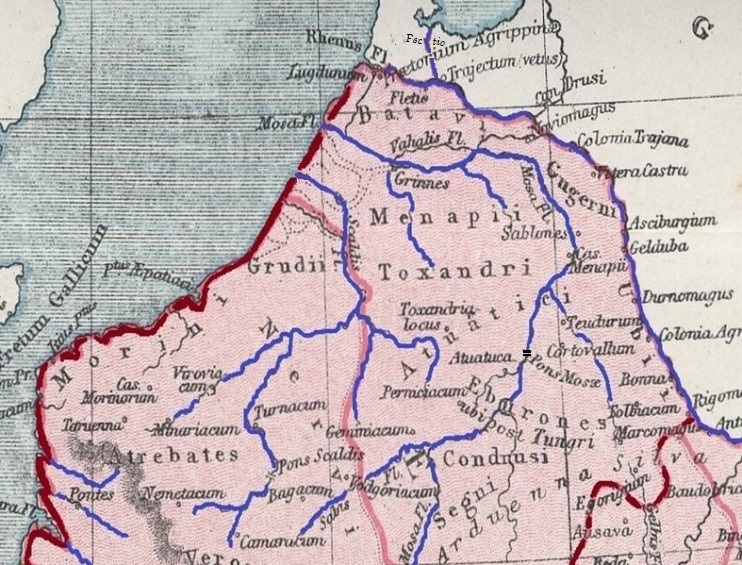
The Belgians at the beginning of our era.
|
Demographic changes before Roman TimesAt least so it is told by Caesar, the man who omitted many facts to increase his exploits and cover up of genocides, and otherwise exaggerates or invents facts to present these peoples as much more primitive than later is found out that they were. |
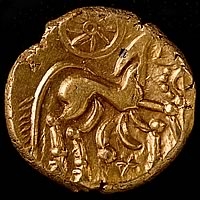
Golden stater of the Nervii |
He says nothing about their advanced hunting weapons, as their boomerangs, while they have had a lot of hostilities and trade. Caesar does not mention, clearly intentionally, that the Belgian peoples struck their own coins and how rich were their temples. Gold prices fell in the Roman Empire when Caesar sold the many gold items he had looted from the Celtic temples after remelting them to gold bullion. (83). |
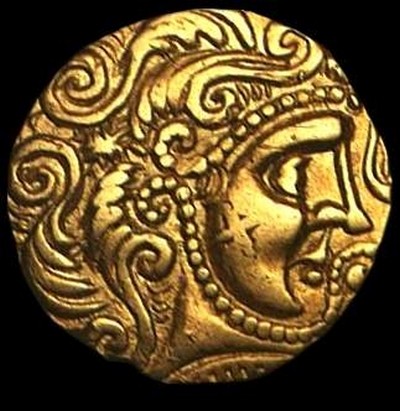
Gold coin of the Eburones |
|
It is clear that the peoples between the Somme and the Weser, the later Netherlands, had their own language group, which was different and probably older than the Celtic and Germanic language groups. The different residential areas varied quite often. In this way the Usipeti and the Tencteri crossed in the year 55 BCE the Rhine, chased away by the Suebi and settled near their related tribe the Sugambri, now east of Roermond on the river Roer. There existed in the time of Caesar in these regions no clear boundaries. The Rhine has been named by Caesar as a border between Gauls (Celts) and Germans. But the Celtic La Tène culture spread across central France, southern Germany and went to the Czech Republic. And in southern Germany lived Celts but no Germans It was Emperor Claudius, 41-54, who after many unsuccessful attempts to conquer Germania Transrhenalis as a border of the Empire, finally took the river Rhine. * Aduatuci and EburonesThese tribes stayed between the Scheldt and the Rhine, with the Aduatuci probably more on the south side of the Somme. This tribe was overcome by Caesar after a final battle at their fortress at the current Thuin. Caesar claimed to have completely wiped out the tribe and their wives and children sold into slavery. In 52 the Eburonic kings Ambiorix, and the old Catuvolcus, together with a number of neighboring nations, formed a confederation against the Romans. The Treveri, Nervii, Aduatuci, Menapii and also some Germans staying on the west side of the Rhine joined them. Caesar collected four legions and invadeed the country of the Nervii. He forced them to surrender and took many prisoners with their cattle. He devastated their country and left it empty. Then Caesar collected a large number of auxiliaries and went to the land of the Eburones. Initially the Eburons won many battles. But the battle gradually turn into guerrilla warfare with varying infiltrations. Thus the fortunes were turned and Ambiorix could only watch how his country was devastated. The old Catuvolcus who no longer could lead the battle killed himself with a potion. (84) |
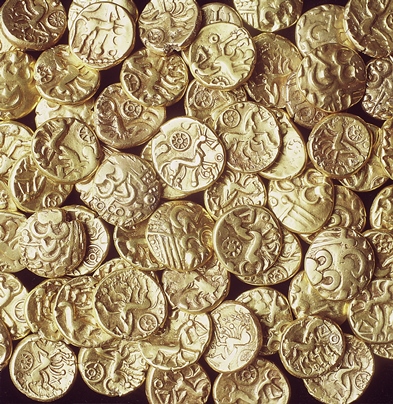
|
Ambiorix was attacked treacherously in his sleep one night. He managed to escape with some faithful and sent messages from across the country that everyone must surrender or find a refuge. Caesar boasted then to have completely destroyed (vastatis) their country as he has done with the Nervii. The Eburones were gone as an independent nation. Pollen Counts in Jülich, the easternmost area of the Eburones show the growth of forests on previous agricultural land. Gold Finds in Heers near Tongeren and Amby at Maastricht are properties that have not been retrieved by their owners. (85). Coin find at Heers near Tongeren (86) |
|
Perhaps only a quarter of the population of Maastricht and Tongeren survived the disaster of 50 BCE. But the population quickly began to flourish. However, no historians at that time wrote about the population of that distant land. We no longer have names. There are from 43 to 23 BCE many indications of small uprisings spread across Gaul, without indicating names or locations. The fortification of Caestert on the edge of the St Pietersberg at Canne south of Maastricht indicates such a struggle. Dendrologic research shows it was built in 31 BCE. We can assume that the population just subsisted. The roman writer Varro cites a visitor of these lands who saw countrymen improve their land with marl in order to reduce the acidity. This limestone is mined in South Limburg around Maastricht. In the years shortly before the beginning of our era a pottery industry of red and black plates and cups flourished on the banks of the Meuse and Scheldt, produced with the previously unkown turntable. Due to the fertile loess soils grain production flourished. With the help of German slave labor there was considerable export of salt, iron, cattle and Ardennes ham. (86a) The main road from Cologne on the fertile loess soils over Tongeren to Boulogne sur Mer and on to England was a trade route on one of the most prosperous regions of Gaul. * Demographic changes in Roman TimesFor the defense of the Northern Borders, treaties were made with German tribes. They were allowed to enter the Empire. They got locations at the edge of the Empire to keep out other interested parties and to become food suppliers and provide recruits for the legions. In our region they are theBatavi and the Tungri, BataviIn our region were the Batavi, a group from Hessen (probably expelled Chatti). They got the island between Meuse and Waal, currently called Betuwe. In the neighborhood lived Cananefates, who resembled them, according to the Romans, in behavior and appearance. They spoke the same language and had lived there longer. The Batavians came to a rather empty land, where there lived less than a hundred thousand people. After their entry, there were about 120,000. The new peoples were placed under supervision of administrative centers. For the Batavians, such a center arose around the current Valkhof in Nijmegen, at the beginning of the first century. In this place there was already a small settlement where some years before the beginning of the era. |

|
Both Tungri and Batavi supplied troops for the Roman Legions: the Batavi infantry, the Tungri infantry as well as cavalry. They fought in many regions under their own leaders with their own banners. On the left you see the banner logo of the Batavi Iuniores, on the right the banner of the Tungri. |

|
|
The Batavi were sent to many places. They were sent to Britain in 360, probably to counter a rebellion. Later the Batavi returned to the continent, but it is unknown when this happened. Four cohorts of the Tungri are known. They saw many places of the Imperium, also Mauretania. |
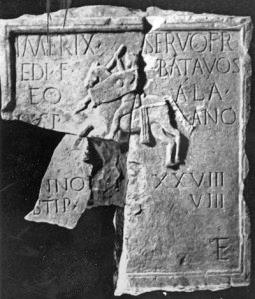
|
Imerix Servofredi is the first person known by name and image from what is now called the Netherlands. He was a Batavian, whose last location was the Roman legion base Burnum, in present-day Croatia, where he possibly died in the days of Emperor Tiberius (14-37) or Caligula (37-41). His tombstone was found there and is now in the Archaeological Museum Zadar. He is depicted in the characteristic equipment of Germanic horsemen with a spear and an elongated hexagonal shield. With the epitaph: IMERIX SERVOFREDI F(ILIUS) BATAVOS EQ(UES) ALA (H)ISPANORUM (A)NNOR(UM) XXXVIII STIP(ENDIORUM) VIII H(IC) S(ITUS) E(ST). Translated: IJmerik Serforts, horseman in the squadron of the Spaniards, eight and twenty years old, with eight years of service, is buried here. (87) |
|
Nothing more is heard of the Batavians. Perhaps they settled in areas where they had served as auxiliaries in the Roman legions, such as Hungary and England, and perhaps even Italy or the eastern borders of Persia. TungriThe Tungri are mentioned by Pliny for the first time a result of the reorganization of Emperor Augustus which was carried out around 20 BCE when the Civitas Tungrorum was formed. It is not clear how they were composed, but many think that it was the former residents of the Sambre and Meuse valley, of the Hasbaye, the Condroz and the Ardennes, who had survived the massacres of Caesar and were caught, together with a group Germani Cisrhenani from the Julich region. A Cohort of Tungri was at Vercovicium (now known as Housesteads, Northumberland) on Hadrian's Wall. The cohort Tungri was split in the time of Hadrian into two Cohorts of Tungri, both cohorts 1000-men strong. In the Batavian war a cohort of Tungri defected to Iulius Civilis. For the Tungri an administrative center Atuatuca was build on the site of the present Tongeren. This was a fortified and walled fortress with stone houses for soldiers and veterans. Here traders settled and markets sprang up. Local gentlemen who built a stone house in the vicinity of the board got magistrate positions. Schools and temples were erected. It seems that the ancient fortress of the Eburones on the edge of Mount St Pieter atCaestert was is abandoned. The fertile Loess region in Germania Belgica has always been one of the richest areas of Gaul. He produced corn, cattle and horse riders but also infantrymen for the Roman legions.
*
| ||||||||||||||||||